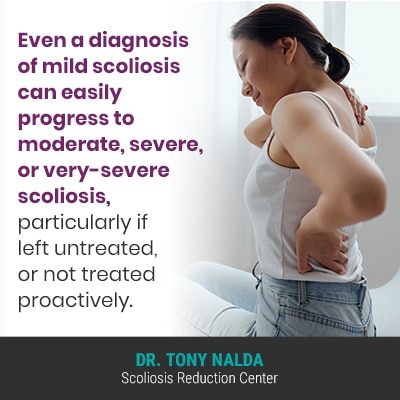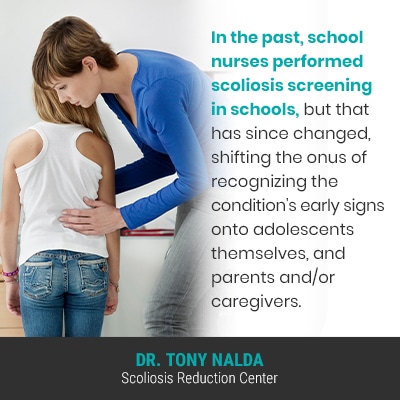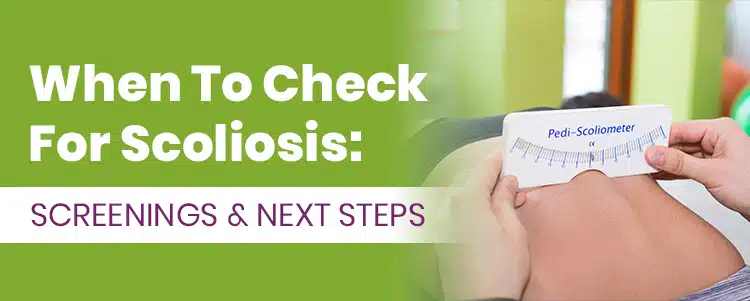Scoliosis is a complex spinal condition that ranges from mild to very severe. As it’s progressive in nature, the importance of when it’s diagnosed, and how that diagnosis is responded to can’t be understated. When it comes to adolescent idiopathic scoliosis, the time to start checking for condition indicators is prior to, and throughout, puberty, as growth and development triggers progression.
When it comes to scoliosis treatment, there are many benefits associated with early detection, but those benefits are only available to patients whose diagnosis is responded to proactively. Knowing the condition’s early signs can help with screening, early detection, and treatment efficacy.
Before getting to the specifics of scoliosis screening and early detection, let’s explore some important condition characteristics.
What is Scoliosis?
Being diagnosed with scoliosis means an unnatural sideways spinal curvature has developed; not only does a scoliotic spine bend unnaturally to the side, it also has a rotational component that makes it twist from front to back, back to front.
In addition to needing a rotational component to be diagnosed as scoliosis, an unnatural spinal curve has to be of a minimum size: Cobb angle of 10+ degrees.
A patient’s Cobb angle is a measurement taken during X-ray that tells me how far out of alignment a scoliotic spine is and classifies conditions based on severity:
Mild scoliosis: Cobb angle measurement of between 10 and 25 degrees
Moderate scoliosis: Cobb angle measurement of between 25 and 40 degrees
Severe scoliosis: Cobb angle measurement of 40+ degrees
Very-severe scoliosis: Cobb angle measurement of 80+ degrees
Condition severity is an important factor for shaping the design of effective treatment plans, but what patients have to understand is that as a progressive condition, where a scoliosis is at the time of diagnosis is not indicative of where it will stay.

Even a diagnosis of mild scoliosis can easily progress to moderate, severe, or very-severe scoliosis, particularly if left untreated, or not treated proactively.
Only proactive treatment can counteract the condition’s progressive nature, but before that can happen, a diagnosis has to be reached, and while it can seem hard to imagine that an unnatural spinal curve wouldn’t be obvious, early detection isn’t always easily achieved.
The Benefits of Early Detection
When it comes to progressive conditions like scoliosis, early detection is highly beneficial as it can mean the difference between starting treatment early in a condition’s progressive line, while still mild, or starting treatment after significant progression has already occurred.
Scoliosis is simplest to treat while mild, and while there are no treatment guarantees at any stage, starting treatment early means there are fewer limits to what we can achieve.
Treating scoliosis while mild means addressing the curve while it’s smaller and easier to treat.
As a scoliotic curve progresses, this means it’s increasing in size, as are the uneven forces being introduced to the body, and alongside progression, spinal rigidity increases, making the spine less responsive to treatment.
In fact, in many cases of adult scoliosis, or in severe cases that have already progressed significantly, work has to be done before starting the regular course of treatment, to restore a baseline level of spinal flexibility.
As a structural condition, scoliosis has to, first and foremost, be impacted on a structural level, and I work towards this through proactive condition-specific chiropractic care that can reposition affected vertebrae back into alignment with the rest of the spine.
In addition, starting treatment early means before the body has had ample time to adjust to the unnatural curve’s presence, meaning the spine’s surrounding muscles haven’t yet felt the condition’s full effects.
As adolescent idiopathic scoliosis is the condition’s most-prevalent condition type, this is the form I’ll currently focus on.
Adolescent Idiopathic Scoliosis
In addition to the fact that scoliosis can range so widely in severity from mild to very severe, there are also different condition types.
The most prevalent type of scoliosis is adolescent idiopathic scoliosis (AIS), diagnosed between the ages of 10 and 18.
The idiopathic designation means we don’t fully understand its causation, but we do know how to treat it, and we do understand what triggers its progression: growth and development.
Due to the stage of puberty characterized by rapid and unpredictable growth spurts, adolescents are at risk for rapid-phase progression, which is why early detection is particularly beneficial for young patients.
While scoliosis is more prevalent in children and adolescents, it also affects adults, but as adults have the progressive trigger of growth removed, they tend to progress at slower rates, and idiopathic scoliosis is also the most common type to affect adults, followed by degenerative scoliosis.
Cases of idiopathic scoliosis in adults highlight the challenge of detecting AIS early on, as these adults had AIS that went undiagnosed and untreated during adolescence, progressing with time and maturity into adulthood.
Scoliosis doesn’t become a compressive condition until adulthood, and this is why most adolescents with scoliosis don’t describe it as overly painful.
Compression of the spine and its surrounding muscles and nerves is the main cause of condition-related pain, but in younger patients who are still growing, their spines are experiencing a constant lengthening motion that counteracts the compressive force of the curve.
Most adult patients with idiopathic scoliosis come in to see me for a diagnosis and treatment because as the condition becomes compressive, its number-one symptom is pain, and this is often radicular pain felt in the hands and feet, due to nerve compression.
The reality is that had these adults received treatment during adolescence, their spines would be in far better shape than by the time they come to see me, but regardless of age or severity, the best time to start treatment is always now; in adults, we want to prevent further damage and aim to reduce a curve back to where it was before becoming symptomatic, and in adolescents, we want to try and counteract progression through growth.
In addition to adolescent idiopathic scoliosis not being overly painful, mild forms aren’t known to cause functional deficits, so with an absence of pain and functional issues, the challenge of early detection is clear.
Scoliosis Symptoms to Watch Out For
While the main symptom of scoliosis in adults is pain, due to the condition becoming compressive once skeletal maturity has been reached, the main symptom of scoliosis in children and adolescents is postural deviation.
Scoliosis introduces a lot of uneven forces to the body, and this can disrupt the body’s overall symmetry, causing changes to posture, gait, balance, and coordination.
Condition severity plays a role in just how noticeable a condition’s effects are, and while each case is different, the earliest signs of scoliosis in adolescents are often uneven shoulders and hips.
In addition to uneven shoulders and hips, signs to look out for include:
- The head seeming uncentered over the torso
- A tilted eye line
- One shoulder blade protruding more on one side than the other
- The development of a rib arch
- An uneven waistline
- Arms and legs that appear to hang at different lengths
Again, the aforementioned scoliosis symptoms are caused by the condition’s uneven forces disrupting the body’s overall symmetry, which is why another sign to check for is clothing suddenly seeming ill-fitting.
While a single body asymmetry doesn’t necessarily mean a person has scoliosis, noticing more than one, or a sudden change to the body’s overall symmetry, does indicate the need for further testing, particularly considering the benefits of early detection for children and adolescents.
Proactive Scoliosis Treatment
I keep using the word proactive, and that’s because how a scoliosis diagnosis is responded to with treatment shapes a patient’s experience of life with the condition, and as an incurable progressive condition, how scoliosis is treated can impact quality of life.
Being proactive with treatment means valuing prevention. As discussed earlier, scoliosis is virtually guaranteed to progress at some point, so waiting for it to do so, and then reacting, as is the strategy with traditional treatment, is wasting valuable treatment time.
Here at the Scoliosis Reduction Center®, if I diagnose a patient with mild scoliosis, though they’re not likely to be feeling lucky, I point out how fortunate it is that the condition was diagnosed while mild, while it’s still so highly treatable.

In the past, school nurses performed scoliosis screening in schools, but that has since changed, shifting the onus of recognizing the condition’s early signs onto adolescents themselves, and parents and/or caregivers.
The reality is that when mild, the condition’s postural changes can be difficult for anyone, other than an expert trained in what to look for, to notice.
So, as the parent of an adolescent who notices some body asymmetries and/or changes to balance and gait, what’s the next step?
Adam’s Forward Bend Test and Scoliosis Screening
If a parent and/or caregiver notices some condition indicators in their adolescent, the next step is to take the child in for assessment by the family doctor or pediatrician.
In most cases, what’s known as an Adam’s forward bend test will be performed, and this involves bending forward at the waist as if trying to touch the toes, with the arms hanging down at the sides.
In this position, any asymmetries in the back are most noticeable, as is the spine, and when combined with the use of a Scoliometer, the angle of trunk rotation (ATR) can be assessed, and indicate whether further testing should be done.
In addition to the Adam’s test, known as the gold standard for scoliosis screening, a doctor is likely to take the patient’s history, including whether scoliosis seems to run in the family, and observe how they hold themselves and walk; I can tell a lot about a patient’s condition by how they walk.
At this stage, if condition indicators are present, the patient will likely be sent for an X-ray, which involves taking a series of measurements to see what’s happening in and around the spine, including the patient’s Cobb angle, and if the parameters needed to reach a diagnosis of scoliosis are fulfilled, a diagnosis is given.
Now, this is the point where there is a fork in the road that patients have to consider carefully: what type of treatment approach to commit to.
Treatment-approach is key because different forms of treatment offer patients different potential outcomes, and when it comes to traditional treatment, we’re talking about a reactive response that commonly funnels patients towards invasive spinal fusion surgery.
Conclusion
Once performed by schools, scoliosis screening is now the responsibility of watchful parents and caregivers.
While scoliosis isn’t officially classified as genetic, it is considered familial, meaning the the likelihood of developing scoliosis is higher if someone else in the family has been diagnosed; remember, families share a lot more than just their genes.
So for everyone, but especially if scoliosis is in the family, I would suggest staying on top of routine check ups, including requesting the Adam’s forward bend test to be done every time, plus staying educated on the condition’s subtle signs that indicate the need for further testing.
The bottom line is that, especially when it comes to children and adolescents, progression means the condition is worsening, symptoms are likely to escalate, and it’s going to get harder to treat, possibly requiring more invasive forms of treatment in the future.
The reality is that most cases of scoliosis can be treated nonsurgically, especially if caught early on and responded to proactively.
Here at the Center, I respond to each diagnosis of AIS with treatment started as soon as possible, in an effort to counteract progression caused by growth, escalating symptoms, and the hardships associated with treating scoliosis once severe.




